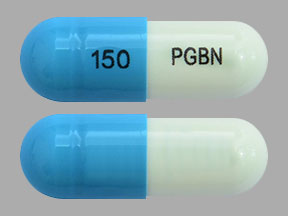Pregabalin Interactions
There are 287 drugs known to interact with pregabalin, along with 6 disease interactions, and 1 alcohol/food interaction. Of the total drug interactions, 28 are major, 258 are moderate, and 1 is minor.
- View all 287 medications that may interact with pregabalin
- View pregabalin alcohol/food interactions (1)
- View pregabalin disease interactions (6)
Most frequently checked interactions
View interaction reports for pregabalin and the medicines listed below.
- Cymbalta (duloxetine)
- Cymbalta (duloxetine)
- Eliquis (apixaban)
- Eliquis (apixaban)
- Fish Oil (omega-3 polyunsaturated fatty acids)
- Fish Oil (omega-3 polyunsaturated fatty acids)
- Jardiance (empagliflozin)
- Jardiance (empagliflozin)
- Metoprolol Succinate ER (metoprolol)
- Metoprolol Succinate ER (metoprolol)
- Metoprolol Tartrate (metoprolol)
- Metoprolol Tartrate (metoprolol)
- Ozempic (semaglutide)
- Ozempic (semaglutide)
- Paracetamol (acetaminophen)
- Paracetamol (acetaminophen)
- Synthroid (levothyroxine)
- Synthroid (levothyroxine)
- Tylenol (acetaminophen)
- Tylenol (acetaminophen)
- Vitamin B12 (cyanocobalamin)
- Vitamin B12 (cyanocobalamin)
- Vitamin C (ascorbic acid)
- Vitamin C (ascorbic acid)
- Vitamin D3 (cholecalciferol)
- Vitamin D3 (cholecalciferol)
- Vyvanse (lisdexamfetamine)
- Vyvanse (lisdexamfetamine)
- Zyrtec (cetirizine)
- Zyrtec (cetirizine)
Pregabalin alcohol/food interactions
There is 1 alcohol/food interaction with pregabalin.
Pregabalin disease interactions
There are 6 disease interactions with pregabalin which include:
- drug dependence
- suicidal tendency
- angioedema
- creatine kinase elevations
- peripheral edema
- PR interval prolongation
More about pregabalin
- pregabalin consumer information
- Compare alternatives
- Pricing & coupons
- Reviews (1,681)
- Drug images
- Side effects
- Dosage information
- Patient tips
- During pregnancy
- Support group
- Drug class: gamma-aminobutyric acid analogs
- Breastfeeding
- En español
Related treatment guides
Drug Interaction Classification
| Highly clinically significant. Avoid combinations; the risk of the interaction outweighs the benefit. | |
| Moderately clinically significant. Usually avoid combinations; use it only under special circumstances. | |
| Minimally clinically significant. Minimize risk; assess risk and consider an alternative drug, take steps to circumvent the interaction risk and/or institute a monitoring plan. | |
| No interaction information available. |
See also:
Tylenol
Tylenol is a pain reliever and a fever reducer used to treat many conditions such as headaches ...
Cymbalta
Cymbalta (duloxetine) is used to treat major depressive disorder, general anxiety disorder and ...
Botox
Botox is used for cosmetic purposes and to treat overactive bladder symptoms, urinary incontinence ...
Naproxen
Naproxen is a nonsteroidal anti-inflammatory drug used to treat pain or inflammation caused by ...
Oxycodone
Oxycodone is an opioid analgesic used to treat moderate to severe pain; it has a high potential for ...
Duloxetine
Duloxetine is a selective serotonin and norepinephrine reuptake inhibitor antidepressant used to ...
Tramadol
Tramadol is an opioid medication that may be used to treat moderate to moderately severe chronic ...
Cyclobenzaprine
Cyclobenzaprine is a muscle relaxant and works by blocking pain sensations. Includes ...
Aspirin
Aspirin is used to treat mild to moderate pain and to reduce fever or inflammation. Learn about ...
Further information
Always consult your healthcare provider to ensure the information displayed on this page applies to your personal circumstances.


